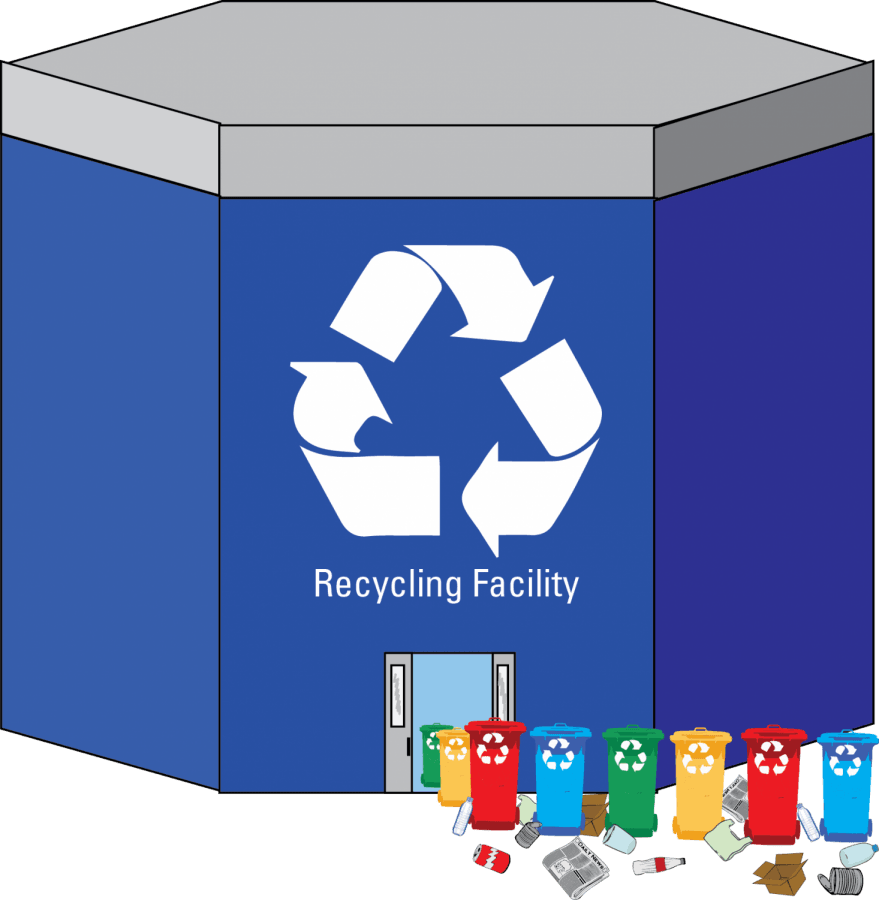Commodities and contamination: The market behind recycling
Annalisa Baranowski | The DePaulia for The DePaulia
For the past few years, Chicago has been recognized for having extremely low recycling rates, with a 9.7 percent rate recorded in 2017.
Independent Recycling Services, a family owned waste and recycling hauler founded in the 1970s, said part of this comes from the lack of knowledge in terms of how the recycling process works and what is considered contamination.
Independent Recycling Services differs from corporate waste management companies in that they don’t own a landfill, so they profit from sorting out recyclable material, reducing the amount they would otherwise have to pay other companies in transfer fees for trash to be transported to a landfill.
Essentially, the recycling industry is a commodity-driven market like any other, so just because a certain material is generally known to be recyclable, doesn’t always necessarily mean it’s getting recycled.
Keisha Glover of Independent Recycling Services explained why glass is often considered contamination.
“There are certain items I always felt so confident recycling…like I’m doing my part putting glass out there because glass is one of those commodities that’s infinitely recyclable,” she said. “It didn’t even occur to me, and I work for a recycling company, that they absolutely don’t want that…it breaks. It fragments out…it just rips cardboard, paper to shreds, rendering all of that unrecyclable.”
Glover said that glass is recyclable, but often times they just say it isn’t because of the risk it poses to the other commodities it’s mixed in with. The general recommendation for glass is to separate it out, which many people don’t like to do since they’ve gotten so accustomed to the single-stream recycling system.
Electronics are another source of contamination when mixed in with regular single-stream recyclables. While they’re recyclable, they’re made up of toxic elements and are hauled separately. In the state of Illinois, it’s illegal to throw away or put electronics in with single-stream recycling materials. Rebecca Quesnell, sustainability coordinator at Independent Recycling Services said electronics are picked up by a separate company.
“It’s a totally different stream,” she said. “It can cause issues with the other recyclables and it’s counted as contamination. It can be flammable…just not a good idea to put that in there.”
Additionally, not all recycling haulers accept the exact same materials and if tenants live in buildings that recycle, but aren’t conscious of their hauler’s program, their items may not be getting recycled. For example, Independent Recycling Services is able to separate out plastic bags because they have manual sorters who separate the materials out, but there are many haulers that don’t accept them because the bags can clog their machines.
Quesnell recommends contacting haulers directly if their landlord doesn’t provide enough information.
“Ask what they accept in their program and maybe get some stickers on the container saying what’s recyclable,” she said.
Labeling is another part of the problem, which Glover said is something the recycling industry is trying to get better about communicating.
“Sometimes you’ll see a recycling can and it’s just a bunch of text and you don’t know…can I put this here? And then you just throw it out because you don’t know what to do with it, or maybe the container itself doesn’t make sense.”
The labeling on materials themselves can also be misleading. Quesnell explained how plastics can sometimes pose a higher risk of contamination because they are made up of a wide range of synthetic compounds. Plastic, though, is often one of the main materials people try to recycle, partly due to the numbered recycling symbol on the bottom of products like water bottles. These are actually resin codes which indicate to companies like Independent Recycling Services how desirable the plastic is.
“These resin codes identify what the product is made out of, not necessarily indicative that it can be recycled easily,” Glover said. “So the contamination risk is that we could receive a lot of plastics that may be extremely difficult to recycle.”
While some landlords still don’t provide recycling programs at all, there are some resident buildings that don’t have access to enough recycling bins to put their materials.
“What’s interesting now is say you live in a 32-unit building, you have three metal dumpsters and they’ll give one little cart for recycling,” Glover said. “In my household, the majority of what I have is recyclable so I could never understand why we have a small cart, and then big dumpsters for trash.It was almost encouraging us to just throw it away and maybe the recyclers will sort it out.”
Separating recyclables from trash doesn’t happen, although this is what many people assume happens when a recycling hauler like Independent Recycling Services picks up their trash. Glover said it’s important to make this distinction because even though they’re primarily a recycling hauler, they run two routes and recyclables aren’t sorted out from trash.
“I can attest that when it all gets compacted it gets pretty contaminated and very hard to extract value out of,” she said. “It’s nearly impossible.”
Gail Selleg, an avid recycler and Pilsen resident of 16 years, recognizes that a lot of what gets put in garbage dumpsters is recyclable and does her best to reduce this.
“I sort the garbage on one full alley that I live on,” she said. “It really reduces landfill trash quite a bit. I can usually collect at least one-third of a tall kitchen bag each week the night before recycling is picked up.”
Glover said education and communication between the industry and consumers are key parts to improving our recycling. Encouraging the other two Rs, reducing and reusing, are just as important.
“We are trying to communicate better methods to communicate how to best improve…and sometimes it’s refusing,” Glover said. “That’s one of the things we’re trying to highlight now is refusing to support packaging that isn’t readily or easily recyclable and just assuming that the hauler is able to take care of it.”







